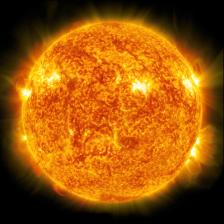What’s the Difference Between a Solar Eclipse, a Lunar Eclipse, and a New Moon?
Ask Science answers 3 common questions about eclipses. Plus – why does the moon turn blood red?
This week, my family woke up at 4am to see the lunar eclipse. There’s nothing quite like watching the Moon turn to blood to start your day.
As I was watching the Moon fade to a dull red color, I started to think about the cosmic conjunction required to make an eclipse. That’s why today I want to answer some questions I’ve received from Ask Science readers and listeners about eclipses:
Sponsor: Want to save more, invest for the future, but don’t have time to be a full-on investor? Betterment.com helps you build a customized, low-cost portfolio that suits your goals. Learn more.
Question #1: How does a solar eclipse work?

Have you ever stood in a room that had multiple light sources? That’s how you end up with multiple shadows. Since the Sun is quite a bit bigger than the Moon, the rays of light coming from the Sun can be thought of as multiple light sources as well. The ones coming straight at the Moon are completely blocked, creating the total eclipse area called the “umbra.”
However the ones coming at an angle towards the Moon are only partially blocked. These make a partial shadow area called the “penumbra.” If you’re in the penumbra region, you only see a partial eclipse, because from your point of view, part of the Moon is still receiving light.
Question #2: How does a lunar eclipse work?

The reason the Moon looks red is that as the sunlight passes through the edges of the Earth’s atmosphere, its shorter wavelengths are scattered. (See the episode on Why Is the Sky Blue for more details). Because of this scattering, only the longer wavelengths of red light make it through to the Moon. (This is also why the Sun looks red as it sets).
Question #3: What’s the difference between a lunar eclipse and a new moon?
Well, one is an astronomical event, and the other is a book about vampires.
OK, corny jokes aside, a new moon occurs when the side of the Moon receiving sunlight is facing away from the Earth. Now you might be thinking, “Doesn’t that happen when the Moon is between the Sun and the Earth? If so, why isn’t there a solar eclipse every time there is a new moon?”
Well the fact is that every solar eclipse is a new moon, but not every new moon is a solar eclipse.
To understand this, imagine the Earth going around the Sun. Now, draw a line between the center of the Sun and the center of the Earth, we’ll call this line the “node line.”

Every time the Moon is at its closest point to the Sun, it’s a new moon. But if the Moon is above the node line when this happens, its shadow passes above the Earth. Likewise, if the Moon is below the node line, its shadow passes below the Earth.
See also: Is it a Star or a Planet?
It is only a solar eclipse when the Moon is at its closest point to the Sun and simultaneously crossing the node line.
Similarly, it is only a lunar eclipse when there is a full moon (which occurs when the Moon is furthest from the Sun) and the Moon is simultaneously crossing the node line.
 Conclusion
Conclusion
So now you know more about solar eclipses, lunar eclipses, and what makes them different from a new moon.
If you have a question that you’d like to see on a future episode, send me an email at everydayeinstein@quickanddirtytips.comcreate new email or post it in the Comments section of this episode. If you liked today’s episode, you can become a fan of Ask Science on Facebook or follow me on Twitter, where I’m @QDTeinstein.
Solar eclipse and lunar eclipse images created by Lee Falin.
Betterment LLC is an SEC Registered Investment Advisor. Brokerage services are offered by Betterment Securities, an SEC registered broker-dealer and member FINRA/SIPC. Investments are not FDIC Insured. No Bank Guarantee. May Lose Value. Investing in securities involves risks, and there is always the potential of losing money when you invest in securities. Before investing, consider your investment objectives and Betterment’s charges and expenses. Not an offer, solicitation of an offer, or advice to buy or sell securities in jurisdictions where Betterment and Betterment Securities are not registered.
You May Also Like…



 Conclusion
Conclusion


